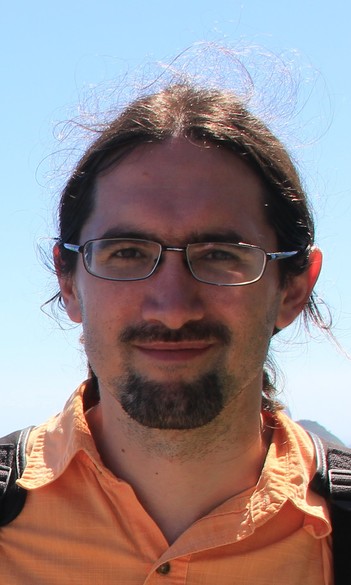Bence Kocsis

assistant professor (2015-2020)
PhD (Eötvös Loránd University, Budapest, 2007)
Department of Atomic Physics
GALNUC Astrophysical Dynamics and Statistical Physics of Galactic Nuclei
Extension(s): +36-1-372-2500 / 6342
Homepage: sns.ias.edu
Email: uh.etle.ktt@siscokb
Biography:
Bence Kocsis is an assistant professor at Eotvos University and the PI of the ERC Starting Grant GALNUC: Astrophysical Dynamics and Statistical Physics of Galactic Nuclei. Before coming to ELTE, he was a three year member of the Institute for Advanced Study (Princeton) and a NASA Einstein Fellow at Harvard University.Bence Kocsis did his undergraduate (1999-2004) and PhD (2004-2007) studies at Eotvos University and was a member of the Bolyai College. His masters and phd theses were on the Sunyaev-Zeldovich effect and gravitional wave astrophysics respectively. He completed an undergraduate summer project at Harvard on planetary dynamics in 2002 and a SURF project at LIGO, Caltech on gravitional waves in 2003. This was historically the first scientific collaboration between Eotvos University and LIGO. Kocsis made several research visits to Columbia University during his PhD studies and spent the last year of his graduate studies at Harvard as a predoctoral and Oveges fellow.
Bence Kocsis works on a wide range of topics in theoretical astrophysics including gravitational wave astrophysics using LIGO/VIRGO, LISA, and pulsar timing arrays, astrophysical dynamics, dense star clusters, astrophysical general relativity, black holes physics from stellar mass to supermassive scales, accretion disks, disk-satellite interactions, and statistical mechanics. He made several unexpected theoretical predictions for novel astrophysical applications of gravitational waves. He pointed out that LIGO will be sensitive to gravitational wave bremsstrahlung radiation of black holes in galactic nuclei and globular clusters. These sources are lead to eccentric inspirals which are more intense, last longer, and have a much richer frequency spectrum than regular circular inspiraling gravitational wave sources, and may teach us about their astrophysical host environments. Secondly, supermassive black hole (SMBH) binaries are the standard targets for pulsar timing arrays and LISA detections of gravitational waves. Kocsis has shown that ambient gas surrounding the SMBH binary changes the expected gravitational wave signal for detections and lead to electromagnetic counterparts. Thirdly, he made the unexpected prediction that pulsar timing arrays are also sensitive to stellar and intermediate mass black holes in the Milky Way, and these observations can generate high resolution maps of the Galactic center. Fourth, he has shown that the weak interaction of gravitational waves with matter may be sufficient to generate a detectable infrared flare in a gaseous disk and may heat stars. Fifth, he pointed out that LIGO will be sensitive to supermassive black holes as they generate gravitational wave echos of stellar mass black hole mergers in galactic nuclei. He has also shown that black hole mergers in globular clusters have universal characteristics (namely that the merger probability scales with the 4th power of binary mass) that can be recovered from a statistical sample of gravitational waves. With Imre Bartos he has pointed out that black hole mergers may efficiently merge in active galactic nuclei due to interactions with gas. He has also shown that the supermassive black hole may help drive the binary to merge due to the octupole Kozai-Lidov effect. In three recent papers in Physical Review Letters, he has pointed out that the stellar envelope expansion and gas fallback in a dyeing star may catalyze the black hole merger process, that disrupted globular clusters may significantly contribute to the black hole merger rate observed by LIGO/VIRGO, and that black holes populations are expected to form disks in galactic nuclei.
Kocsis has also discovered a tantilizing connection between astrophysical systems and condensed matter. Namely, the orbital planes of stars and compact objects in galactic nuclei and globular clusters exhibit order/disorder phase transitions as a function of distance and mass. The Hamiltonian that describes this process has close connections with that of liquid crystals, vortex crystals, and spin glasses.
Kocsis has taught courses in classical mechanics, electrodynamics, Ortvay advanced problem solving course, introduction to astrophysics, galactic dynamics, black hole physics. He coadvised the PhD research of Ryan O'Leary, Bence Beky, and Gongjie Li at Harvard and Laszlo Gondan at Eotvos. He was the master's thesis advisor of Akos Szolgyen and Gergely Mathe. He is currently the phd advisor of Akos Szolgyen, Gergely Mathe, and Barnabas Deme.
Links to associated scientific database profiles:
- Publications in MTMT
- Publications in ORCID
- Publications in ResearcherID
- Publications in Scopus
- Publications in Google Scholar
- Publications in adsabs.harvard.edu
- Publications in arxiv.org
- User profile at doktori.hu
Selected publications of recent years:
- Á. Szölgyén, B. Kocsis, Black Hole Disks in Galactic Nuclei, PRL, 121, 101101 (2018)
- G. Fragione, B. Kocsis, Black Hole Mergers from an Evolving Population of Globular Clusters, PRL, 121, 161103 (2018)
- H. Tagawa, T. Saitoh, B. Kocsis, Compact Object Mergers Driven by Gas Fallback, PRL, 120, 261101 (2018)
- L. Gondán, B. Kocsis, Measurement Accuracy of Inspiraling Eccentric Neutron Star and Black Hole Binaries Using Gravitational Waves, ApJ, 871, 178 (2019)
- B. Kocsis, T. Suyama, T. Tanaka, S. Yokoyama, Hidden Universality in the Merger Rate Distribution in the Primordial Black Hole Scenario, ApJ, 854, 41 (2018)
- Á. Takács, B. Kocsis, Isotropic-Nematic Phase Transitions in Gravitational Systems. II. Higher Order Multipoles, ApJ, 856, 113 (2018)
- Z. Roupas, B. Kocsis, S. Tremaine, Isotropic-Nematic Phase Transitions in Gravitational Systems, ApJ, 842, 90 (2017)
- R. M. O'Leary, Y. Meiron, B. Kocsis, Dynamical Formation Signatures of Black Hole Binaries in the First Detected Mergers by LIGO, ApJ, 824, 12 (2016)
- B. Kocsis, S. Tremaine, A numerical study of vector resonant relaxation, MNRAS, 448, 3265 (2015)
- T. D. Brandt, B. Kocsis, Disrupted Globular Clusters Can Explain the Galactic Center Gamma-Ray Excess, ApJ, 812, 15 (2015)

